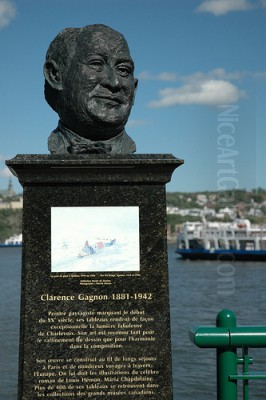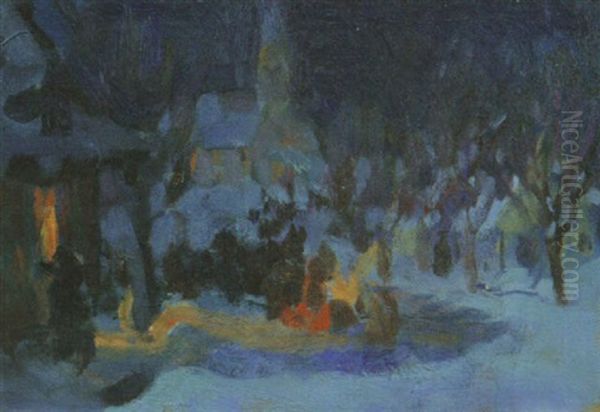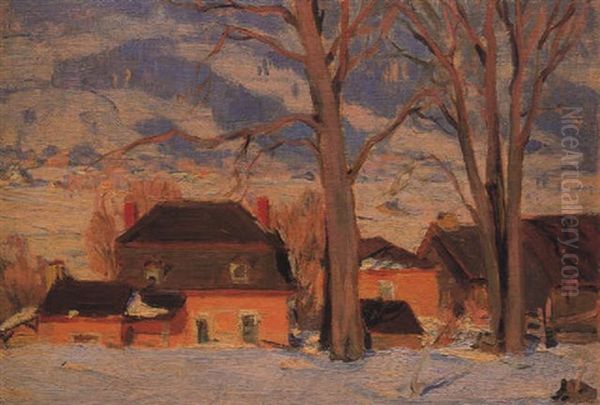
Clarence Alphonse Gagnon stands as a significant figure in the annals of Canadian art history. Born on November 8, 1881, in Montreal, Quebec, and passing away on January 5, 1942, Gagnon was a multifaceted artist celebrated primarily as a painter, but also accomplished as a draughtsman, engraver, and illustrator. His legacy is deeply intertwined with his evocative portrayals of the Quebec landscape, particularly the Charlevoix and Laurentian regions, capturing the spirit and beauty of his native land with a unique sensitivity to light and atmosphere.
Early Life and Artistic Calling
Gagnon's journey into the world of art began in Montreal. His father, Alphonse E. Gagnon, was a mill owner with practical business aspirations for his son. However, his mother, an educated English woman with a keen interest in literature, perhaps fostered a different sensibility in the young Clarence. His childhood was spent partly in Sainte-Rose, a small village north of Montreal, which likely exposed him early on to the rural landscapes that would later dominate his work.
Despite his father's initial hopes for a career in commerce, Gagnon's artistic inclinations proved stronger. At the age of sixteen, around 1897, he commenced formal art training. His first significant mentor was William Brymner, a foundational figure at the Art Association of Montreal. Brymner's guidance provided Gagnon with a solid grounding in academic principles, setting the stage for his future development.
Parisian Apprenticeship and European Influences
Seeking to broaden his artistic horizons, Gagnon subsequently traveled to Paris, the epicenter of the art world at the time. There, he enrolled at the prestigious Académie Julian, studying under the respected academic painter Jean-Paul Laurens. This period was crucial for Gagnon, exposing him to the vibrant currents of modern European art, including Impressionism and Fauvism, although he would ultimately forge his own path.

While in Paris, Gagnon absorbed various influences. He studied etching under the American artist Donald Shaw MacLaughlin, developing skills that would lead to significant work in printmaking. He was also reportedly influenced by the Barbizon school and the works of artists like Horace Walker Renouf (as mentioned in source material). Critically, he connected with fellow Canadian expatriate James Wilson Morrice, learning valuable techniques in plein air (outdoor) sketching, a practice that became fundamental to his landscape painting.
The Parisian environment, bustling with artistic innovation, undoubtedly shaped Gagnon's technique and perspective. He encountered the revolutionary works of Impressionists and Post-Impressionists, observing their approaches to light and colour. While he admired these movements, Gagnon maintained a distinct artistic identity, filtering these influences through his own temperament and connection to his homeland.
European Horizons and the Etcher's Needle
Gagnon's time in Europe was not confined to Paris. He traveled extensively, visiting Italy, Spain, Switzerland, and the Netherlands. These journeys further enriched his artistic vision and provided new subjects for his work. During this period, particularly between 1905 and 1910, he produced a notable body of etchings that gained international recognition.
Works such as Grand Canal, Venice and Rue de Canteleu, Canteleu showcase his mastery of the etching technique, characterized by fine lines, atmospheric depth, and a keen eye for architectural detail and scenic beauty. These prints were exhibited in Europe and North America, finding their way into important collections, including those of the Victoria and Albert Museum in London and various French galleries, solidifying his reputation beyond Canada.
His success as an etcher demonstrated his versatility and technical skill. It also provided him with a different medium through which to explore themes of light, shadow, and place, complementing his work in oil painting. This European phase was instrumental in establishing Gagnon as an artist of international standing.
The Heart Returns to Quebec
Around 1908, Gagnon returned to Canada, choosing to settle in the picturesque village of Baie-Saint-Paul in the Charlevoix region of Quebec. This area, along with the nearby Laurentians, would become the heartland of his artistic production for much of his adult life. He established deep connections within the local community and found endless inspiration in the rolling hills, winding rivers, and traditional life of the region.
In Baie-Saint-Paul, Gagnon dedicated himself to capturing the essence of the Quebec countryside. He continued the practice of outdoor sketching learned from Morrice, creating numerous small studies directly from nature. These sketches often served as the basis for larger, more finished canvases completed in his studio. His focus shifted decisively towards Canadian subjects, particularly the landscapes he knew and loved so intimately.

His paintings from this period depict the tranquility and simplicity of rural Quebec, often imbued with a sense of timelessness. He was particularly drawn to the effects of snow and the unique light of the Canadian winter, becoming one of the preeminent painters of winter scenes in Canadian art history.
Defining a Canadian Vision: Style and Subject
Clarence Gagnon's artistic style is often characterized as a synthesis of influences, blending the academic rigor of his early training with the atmospheric concerns of Impressionism. He developed a distinctive approach to landscape painting, marked by a sensitive handling of light and colour. Critics often noted the delicate, almost pastel-like quality of his palette, even in his oil paintings.
He is particularly renowned for inventing a new style for depicting winter landscapes. His winter scenes feature mountains and valleys rendered with vibrant, contrasting colours, yet harmonized through skillful composition and often characterized by sinuous, flowing lines. He captured the crisp air, the deep shadows, and the brilliant sunlight on snow with remarkable fidelity and poetic feeling.
Gagnon's commitment to his homeland was profound. He famously stated, "I only paint Canadian subjects, I dream of Canada." This deep connection is evident in his work, which goes beyond mere representation to convey a deep affection for the land and its people. His paintings often carry an idyllic, pastoral quality, celebrating the enduring traditions and quiet beauty of rural Quebec life. Influences from Post-Impressionists like Paul Cézanne and Georges Seurat might be discerned in his structured compositions and attention to colour relationships and light effects, adapted to his own unique vision. Comparisons were even drawn by contemporaries to the light handling of artists like Edouard Manet.
Landmarks in Paint and Print
Gagnon's oeuvre includes numerous celebrated works. Early pieces like Beach Scene, St. Malo reflect his time in Europe and his engagement with Impressionist techniques, capturing the fleeting effects of light on water and sand. However, his most iconic works are those rooted in the Quebec landscape.
Paintings such as Hills of Baie-Saint-Paul, Winter and Twilight, Baie-St-Paul exemplify his mature style. These works showcase his mastery of colour, his ability to convey the specific atmosphere of the Canadian winter, and his deep emotional connection to the Charlevoix region. Works like Midnight Mass further explore the intersection of landscape and rural community life.

Beyond his landscape paintings, Gagnon achieved significant recognition for his illustrations for Louis Hémon's classic novel Maria Chapdelaine. Published in 1933, these illustrations are considered a major achievement in Canadian book illustration. Gagnon spent years perfecting the images, ensuring they captured the spirit and setting of Hémon's tale of pioneer life in rural Quebec. The illustrations possess a romantic, evocative quality that perfectly complements the text and have become inseparable from the novel in the Canadian imagination.
A Network of Artistry
Throughout his career, Gagnon interacted with and was influenced by a network of artists. His initial training under William Brymner provided a crucial foundation. In Paris, his studies with Jean-Paul Laurens and his association with James Wilson Morrice and Donald Shaw MacLaughlin were formative. His work shows an awareness of broader European movements, engaging with the legacies of Impressionism (represented by figures like Claude Monet and Pierre-Auguste Renoir) and Post-Impressionism (Paul Cézanne, Georges Seurat).
While absorbing these influences, Gagnon maintained a strong sense of artistic independence. He forged a path distinct from many of his Canadian contemporaries, focusing intently on the Quebec landscape rather than aligning himself fully with burgeoning modernist groups like the Group of Seven, though his work certainly contributed to the growing sense of national identity in Canadian art. His connection to the literary world through the Maria Chapdelaine project also highlights his engagement with Canadian culture beyond painting, linking him to the author Louis Hémon.
Recognition and Esteem
Clarence Gagnon's artistic achievements earned him considerable recognition during his lifetime and continue to be celebrated today. He was elected an Associate of the Royal Canadian Academy of Arts (RCA) in 1910 and became a full Academician in 1922, signifying his high standing within the Canadian art establishment.
His works were widely exhibited both in Canada and internationally, particularly in France, Britain, and the United States. Major institutions acquired his paintings and etchings, including the National Gallery of Canada, the Montreal Museum of Fine Arts, and numerous provincial galleries, as well as international museums like the Victoria and Albert Museum in London.
Gagnon's paintings remain highly sought after by collectors. His depictions of the Quebec landscape, especially his luminous winter scenes, are considered iconic representations of Canadian scenery and identity. His work continues to be featured in exhibitions exploring Canadian art history, cementing his place as a key figure.
Later Years and Enduring Legacy
In his later years, Gagnon adopted a somewhat conservative stance towards the more radical developments in modern art, expressing skepticism about trends he felt were moving too far from nature and traditional craftsmanship. This perspective perhaps reflected his deep grounding in observational painting and his commitment to representational art, albeit infused with modern sensibilities regarding colour and light.
He was known not only as an artist but also as a personality. An anecdote mentions his attempt to establish a social circle of artists and friends in Montreal, a venture that, while short-lived, spoke to his desire for community and his engaging character.
Unfortunately, Gagnon's later life was marked by declining health. He suffered from pancreatic cancer and passed away in Montreal on January 5, 1942, at the age of 60.
Clarence Alphonse Gagnon's influence on Canadian art is undeniable. He stands as a master interpreter of the Quebec landscape, particularly its winter guise. His ability to blend European techniques with a deeply felt Canadian sensibility created a body of work that is both technically accomplished and emotionally resonant. He captured the light, the atmosphere, and the enduring spirit of his native land, leaving behind a legacy that continues to inspire and captivate audiences, securing his position as one of Canada's most beloved and important artists.